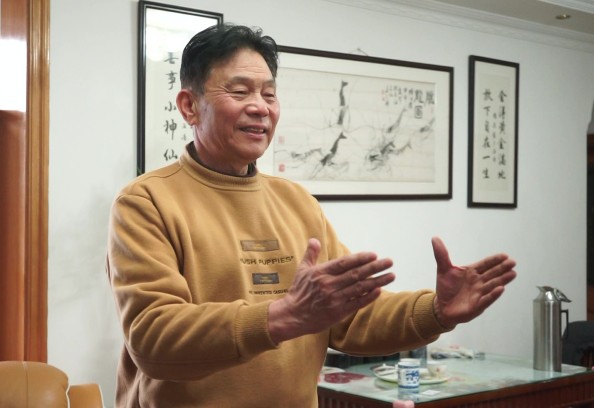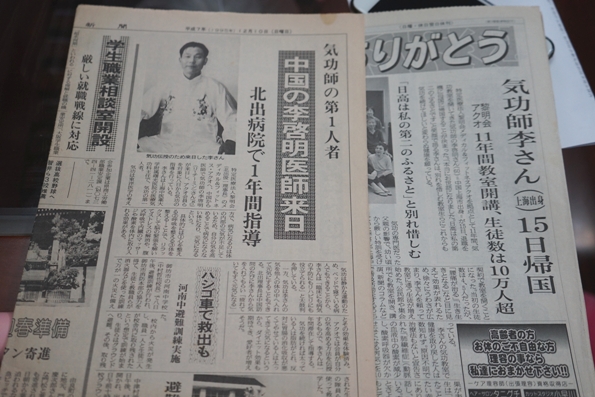
2019-4-28
By:Fan Yicheng, Yu Shicheng
Neigong massage is a traditional Chinese art of building up strength through breathing and other internal organ exercises. It is also an important part of traditional Chinese medicine. In recent years, with the gradual popularization of Chinese qigong overseas, Shaolin-neigong massage has captured wide attention in Japan. A number of relevant articles have appeared in several authoritative medical journals of Japan.

(Photo by Fan Yicheng)
"I hope that more people could realize the benefits of neigong massage around the world, and they could find much to their profit in it," said Li Qiming, the famous practitioner and evangelist of traditional Chinese medicine who has popularized Shaolin-neigong throughout his life. In 1995, Li was engaged as a traditional Chinese medical advisor by the Health Centre of Gobo, Wakayama city, Japan, and he still travels to Japan every year to spread neigong massage after retiring.
In Li's words, neigong massage could be defined as traditional Chinese aerobics to strengthen the body, but not to be used to fight. People could use neigong massage to keep fit, as the constant moderate intensity workout it provides uses up oxygen at a rate equivalent to that which the cardio respiratory system can replenish oxygen in the working muscles. Li told us that simple neigong massage actions are easy to learn, and people can perform them anywhere.
Shaolin-neigong is an important part of traditional neigong massage, focusing on the exercise of the waist and upper limbs. The exercise is used to relax muscles, relieve stress and improve circulation. Neigong massage has been listed in the extended category of China’s intangible cultural heritage.
Li Qiming and his older brother learnt neigong massage from their father, who opened the famous neigong clinic in 1937. There were a lot of patients seeing him at that time. Li started to study dirigation (the power of controlling or modifying involuntary bodily functions, such as thepulse, temperature, or digestion) when he got into college. He was later employed as the botanic physician of the Medical Qigong department of Shanghai University’s TCM affiliated hospital. During this period, Li also helped the Shanghai University TCM hospital and the State Administration of TCM of the PRC to collect and assort plenty of literature about neigong and traditional Chinese medicine, whose contents had passed into Chinese medical text books.
In 1993, Li met Shunichi Kitade, the president of Kitade Hospital in Wakayama, Japan. Kitade favored traditional Chinese medicine very much. Through the medical communications with China's hospitals, he wished to employ a good practitioner of traditional Chinese medicine from China. After Kitade made his requests to Shanghai's government, Li Qiming was nominated soon after.

Two years later, Li went to Japan with Kitate to open neigong classes. In the beginning, there were only five people attending the class, but there are now more than 50 people. Shaolin-neigong is now more widely known among Japanese. “I am appreciative to meet Li and Chinese neigong massage," Kitade said, before adding that Shaolin-neigong helped him to cure chronic enteritis.
According to the quantitative research fromthe Osaka Prefecture University, Shaolin-neigong can improve human physical functions rapidly, and it also helps people to tone up their systems if they keep doing regular Shaolin-neigong exercises. During the research observation, neigong massage had obviously cured some chronic diseases, and improvedlong-term endurance. The results of the research were published in the top scientific journal Health. The son of Shunichi Kitade also reported the positive therapeutic evaluation of Shaolin-neigong through the World Forum of Chinese Medicine 2015.

Over one-hundred-thousand Japanese people have joined Li's classes over the last decade. " All of my students came to my class to take regular exercises at least once per week, and also performed some exercises at home every day," said Li. After he retired, he still tried to conduct medical cooperation and sincere exchanges between China and Japan.
Shaolin-neigong has helped a large number of people to invigorate their health. Li hopes more and more people could understand the benefits of neigong and Chinese medicine in the future, believing them to be human medical treasure.